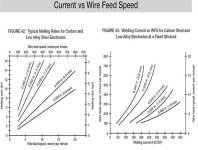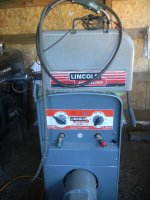from another site: Welding machines are usually classified as constant current (CC) or constant voltage (CV); a constant current machine varies its output voltage to maintain a steady current while a constant voltage machine will fluctuate its output current to maintain a set voltage. Shielded metal arc welding will use a constant current source and gas metal arc welding and flux-cored arc welding typically use constant voltage sources but constant current is also possible with a voltage sensing wire feeder.
The nature of the CV machine is required by gas metal arc welding and flux-cored arc welding because the welder is not able to control the arc length manually. If a welder attempted to use a CV machine to weld with shielded metal arc welding the small fluctuations in the arc distance would cause wide fluctuations in the machine's output. With a CC machine the welder can count on a fixed number of amps reaching the material to be welded regardless of the arc distance but too much distance will cause poor welding.
The nature of the CV machine is required by gas metal arc welding and flux-cored arc welding because the welder is not able to control the arc length manually. If a welder attempted to use a CV machine to weld with shielded metal arc welding the small fluctuations in the arc distance would cause wide fluctuations in the machine's output. With a CC machine the welder can count on a fixed number of amps reaching the material to be welded regardless of the arc distance but too much distance will cause poor welding.


